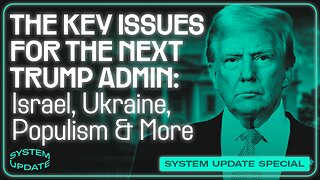Premium Only Content

Demystifying ISF and AMS: Understanding the Differences in Customs Clearance
ISF Entry | Phone: 800-215-1849 | Email: isf@isfentry.com | https://isfentry.com/
In today's video, we deep dive into the important topic of ISF (Importer Security Filing) and AMS (Automated Manifest System), two automated systems used in the customs clearance process. We discuss the timing of submission, filing responsibilities, consequences of non-compliance, required data elements, and the purpose of each system.
Firstly, we highlight the timing of submission; ISF filing must occur at least 24 hours before the vessel departs, while AMS requires manifest data to be submitted no later than 24 hours before the vessel arrives at a US port. This distinction showcases the focus of ISF on gathering information before cargo departure and AMS on manifest data before cargo arrival.
Next, we outline the parties responsible for filing; ISF is the responsibility of the importer or their authorized agent, while AMS is typically filed by the ocean carrier. These filing responsibilities differ due to the specific information required by each system.
Moving on, we discuss the consequences of non-compliance. In the case of ISF, penalties such as liquidated damages, cargo holds, or denial of cargo release may be imposed. For AMS, non-compliance can result in fines, vessel holds, or exclusion from trade participation.
Furthermore, we detail the distinct data elements required by each system. ISF requires information such as importer of record number, consignee number, and manufacturer ID. AMS, on the other hand, necessitates data such as vessel name, voyage number, bill of lading number, and container seal numbers.
Finally, we address the purpose of each system. ISF enhances cargo security and provides CBP with advance information about incoming shipments, allowing for identification of potential security risks beforehand. AMS streamlines the customs clearance process by enabling CBP to review cargo information before arrival, ensuring efficient handling of goods.
To conclude, understanding the differences between ISF and AMS is pivotal for importers and industry professionals to ensure compliance and smooth customs clearance. Each system serves a distinct purpose, has unique filing requirements, and carries specific consequences for non-compliance. We encourage you to subscribe to our channel for future videos and comment with any further questions or topics you'd like us to cover. Thank you for watching, and we look forward to bringing you more informative content in our next video.
#usimportbond
#isfcustomsbroker
#uscustomsclearing
#isfentry
Video Disclaimer Here: This educational content is unassociated with US governmental bodies.
0:38 - A requirement by U.S. Customs and Border Protection (CBP) for importers to submit cargo information before it arrives in the U.S
0:55 - A system for ocean carriers to submit manifest data electronically to CBP before vessel arrival in the U.S
1:07 - ISF Must be filed at least 24 hours before the vessel departs from the last foreign port.
-
 2:19:43
2:19:43
TheSaltyCracker
6 hours agoCybertruck Bomber Manifesto Leaked ReeEEeE Stream 01-03-25
131K218 -
 1:44:12
1:44:12
Roseanne Barr
5 hours ago $11.87 earnedSquid Game? | The Roseanne Barr Podcast #81
63.3K46 -
 1:13:27
1:13:27
Man in America
10 hours ago🚨 2025 WARNING: Disaster Expert Predicts 'ABSOLUTE CHAOS' for America
38.5K19 -

I_Came_With_Fire_Podcast
11 hours agoNew Years TERRORISM, Mexico trying to FAFO, and DARK MONEY to US Think Tanks
16K9 -
 1:47:40
1:47:40
Glenn Greenwald
8 hours agoThe Key Issues Determining the Trajectory of the Second Trump Administration: From Israel and Ukraine to Populism and Free Speech | SYSTEM UPDATE #382
67.1K39 -
 1:02:44
1:02:44
The StoneZONE with Roger Stone
6 hours agoRoger Stone Unveils His 16th Annual International Best and Worst Dressed List | The StoneZONE
30.1K4 -
 45:22
45:22
Kyle Rittenhouse Presents: Tactically Inappropriate
7 hours ago $3.46 earnedKyle Rittenhouse Presents: Tactically Inappropriate
30.5K15 -
 1:13:16
1:13:16
Patriots With Grit
6 hours agoThe Comedy of White Privilege & Government | A.J. Rice
22.9K2 -
 49:40
49:40
Havoc
10 hours agoWhat's 2025 Looking Like... | Stuck Off the Realness Ep. 23
42.3K3 -
 3:58:11
3:58:11
Nerdrotic
10 hours ago $34.89 earnedWOKE Hollywood Freak out, Cyber Truck Attack, 2025 BEGINS! | Friday Night Tights 335 w Benny Johnson
102K23